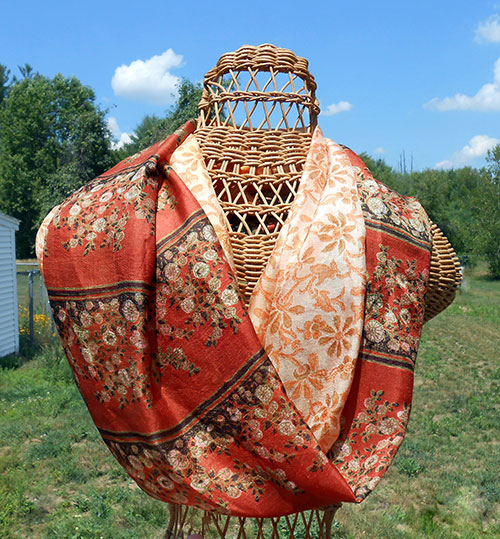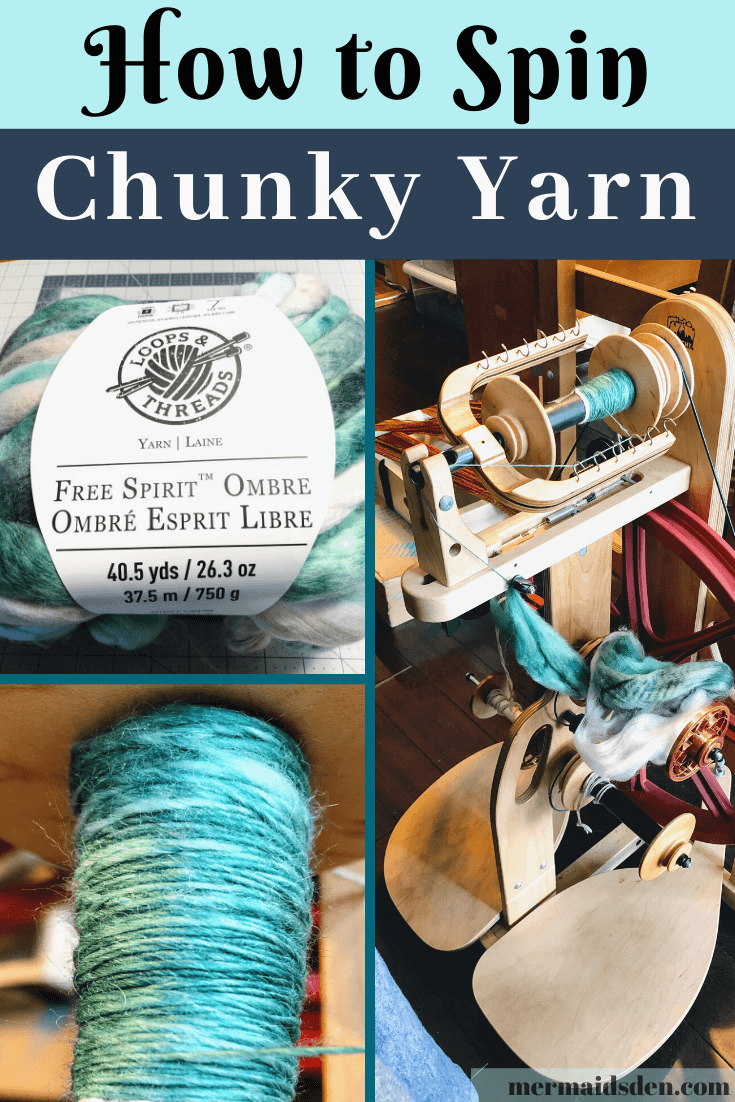Can You Use Arm Knitting Yarn for Spinning?
Lately, I’ve seen bulky arm knitting yarn everywhere, and I thought, that looks a lot like the roving I use for spinning. In fact, I’ve even seen sellers tweak their keywords to make spinning fiber pull double duty as arm knitting yarn! But there are also some dedicated yarns made specifically for arm knitters, and it looks like lightly twisted spinning fiber. So I got some to test out whether it would work as spinning fiber or whether it was processed in such a way that would prevent it from being spun. In this post I’ll go over everything you need to know about using bulky arm knitting yarn with your spinning wheel.
Disclosure: This post contains affiliate links, which means I may receive a percentage if you make a purchase using these links. This won’t cost anything extra to you. See my privacy policy for more details.
See below for a video overview of this post. If you can’t see the video below, try this direct link. While you’re there, don’t forget to subscribe to the Mermaid’s Den Youtube channel.
Normal Spinning Fiber
If you’ve been reading my blog for a while, you’ll know that I love artisan fiber from Etsy that’s been hand prepared or hand dyed (see my fiber gift guide). I have way too many of these braids of fiber hanging around and I can’t seem to stop buying them. They’re addictive!
Can You Use Arm Knitting Yarn for Spinning?
But these braids tend to come in a standard size of 4oz. If you spin a fairly thin yarn, at most, you might be able to get a shawlette out of it, but, for the most part, 4oz will only allow you to make a small project. If you wanted to make a bigger project like a sweater or an afghan, you’d need a lot more fiber, and that starts to get pricey.
Arm Knitting Yarn
This is what piqued my interest in chunky arm knitting yarn, which tends to come in fairly large skeins. It’s so thick that you’d still need a lot of yarn to complete a project if you were using it as the manufacturer intended—for arm knitting—but what if you repurposed it and made a new yarn altogether?
Can You Use Arm Knitting Yarn for Spinning?
I had my eye on some Loops & Threads Free Spirit yarn at Michaels, but it retailed for around $30, and that was a little more than I wanted to spend on a spinning experiment.
Finally my patience paid off. I found it on sale for around $10! At the store, I untwisted it a bit and tried to gently draft it out to see if it would work for spinning, and my tentative conclusion was that: yes, it probably would work, but I’d have to wait until I got it home to really test it out.
Roving vs. Arm Knitting yarn
Can You Use Arm Knitting Yarn for Spinning?
Thickness
So how does this yarn differ from roving that is specifically prepared for spinning? Well, in terms of thickness, it’s not too different from most roving. It’s a little thinner than your conventional braid of fiber, but a little thicker than pencil roving. I usually like to pre-draft my fiber down to a more manageable size, so this was actually a pretty good thickness for me.
Can You Use Arm Knitting Yarn for Spinning?
Fiber Content
In terms of fiber content, spinning fiber tends to be more natural: wool, silk, bamboo, cotton, and so forth. Chunky yarn for arm-knitting tends to have a higher level of synthetic fiber in it.
This one is 60% polyester, 20% acrylic, and 20% wool. I was actually a little surprised to find that it had wool in it at all! But it is a nice soft fiber, and it would work well for anything that might be worn next to the skin, and it would be easier to wash than something that’s 100% wool.
Care and Washing
The packaging notes that you should hand wash anything you make with this yarn, but I think that’s because the arm knitting yarn pulls apart fairly easily if you tug at it. That’s why it works for spinning, too.
But once you’ve refashioned it into a more highly twisted yarn, I think it should be okay to wash. Just wash it carefully because there is a little wool in it, and it could potentially felt. I’d wash anything you make in cold water and probably air dry it. (I might try throwing a sample swatch in the dryer to see how it does. If I do this, I’ll update the post to let you know how the swatch fares in the dryer.)
Weight
In terms of weight, 4oz is fairly standard for spinning fiber, as I noted earlier. This yarn was 26.3 ounces or 1.65 pounds. The most I’ve ever gotten out of a 4oz braid was around 400 yards of double-ply yarn, and my average is more like 200-300 yards, so I should be able to spin a good amount of yarn from this.
Staple length
I pulled off a couple of tufts from the end of the chunk I was working on, and the staple length seems to be around 6-8,” which is a decent length. A lot of wool is between 2-6,” so if you’re used to spinning wool by itself, this will probably feel a little different.
Can You Use Arm Knitting Yarn for Spinning?
How does it spin?
I was worried that the synthetic components might make it harder to spin or that the fiber might have been processed in such a way as to make it hold together for arm knitting. Even though it didn’t feel like it, I was concerned that it might have been lightly felted to help it keep its shape.
Can You Use Arm Knitting Yarn for Spinning?
All of my fears proved unfounded. I broke off a manageable chunk of it (maybe a yard or so), untwisted it to make the fibers easier to release, since the yarn was lightly twisted to help it stay together, and sat down to spin. It didn’t strike me as more difficult than most wool blends. It was pretty smooth spinning fiber, in fact. The yarn I make from it will be very soft and light. I’m looking forward to seeing how it all spins up. Watch the following video to see how it works up on my wheel:
The only problem I encountered after spinning through a few lengths of it was that there were sometimes little bumps or neps in the fiber, but that’s not totally out of the norm for spinning fiber. If you catch them in time, you can pull them out. If not, you’ll get a little bump in your yarn.
Here’s what it looks like on my bobbin so far:
Can You Use Arm Knitting Yarn for Spinning?
Pros and Cons
As I said earlier, this isn’t a super high quality fiber, and it is primarily synthetic. However, you get a lot of it at a pretty reasonable price point when compared to most artisan fibers, and it should be relatively easy to care for and wash. It’s soft and easy to spin, and I’m hoping to eventually make a sweater from this batch of arm knitting yarn. I think the slightly longer staple length makes it easier to spin without breaking the fiber as you go and having to fish the lost end of the yarn off the bobbin and back through the orifice.
Get Your Own Bulky Arm Knitting Yarn
Sadly, the exact one that I’m using in this post seems to have been discontinued, which is probably why it was so heavily discounted. Here are some alternatives that look similar to the one I tested out.
Chunky Luxe Big Yarn by Loops & Threads
This is by the same company, Loops & Threads, but the skein is a little smaller at 10.5 ounces, and it’s all acrylic, rather than an acrylic-wool blend. The reviews of it aren’t great, but the main problem people have is that it comes apart and sheds everywhere. They’re trying to use it for knitting, so that’s unfortunate, but that feedback is a sign that this would be good spinning fiber, too.
And here are some arm knitting yarns that look like they’d be good for spinning on Amazon as well:
Note: Throughout this post, I’m using the word roving as a stand-in for most prepared fiber terms, such as combed top, sliver, etc. I’m using it to encompass both hand-prepared and commercially-prepared fiber. I know there are differences here, but I didn’t want to get bogged down in terminology, so “roving” is meant to cover all of these different types of fiber preparation.

















